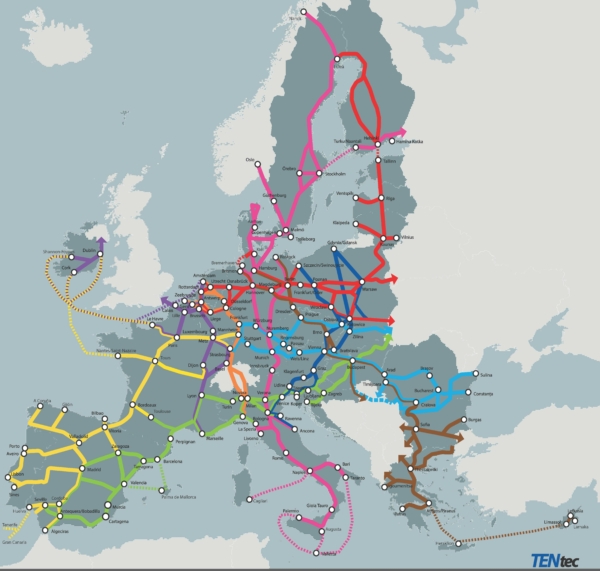 today 138
today 138
Europe has the world’s densest international rail network. With extensions, expansions, and new connections, it will be even denser and more attractive. This will successively lead to a trans-European network by 2050. The Trans-European Transport Network (TEN-T) entails a two-layer structure that will eliminate barriers in freight transport, make direct long-distance connections possible, and improve access to ports. In terms of passenger transport, there will be attractive high-speed and night train connections between most of Europe’s major cities. It is a historic undertaking of unparalleled proportions. TEN-T comprises pan-European plans for railway lines, roads, inland waterways, and air travel. Most of the funding will go towards rail transport. Some projects are already in operation; others are being planned or under construction.
TEN-Transport is the largest European infrastructure and network project alongside those for energy (TEN-E) and telecommunications (eTEN). The aim is to have transnational, coordinated, and multi-modal transport planning of all modes of transport for a pan-European network that eliminates existing bottlenecks and places a strong emphasis on environmental aspects. Deliberations began in 1990, and the legal framework was created in 1996 (1692/96/EC). It has been amended multiple times since then. At the moment, nine “Core Network Corridors” form the basis of this successive implementation. In 2014, a European coordinator was appointed for each corridor. In charge of planning and implementation, this coordinator pools the interests of all stakeholders, from EU Member States to railway companies.
During the first phase, a high-level core railway network is expected to develop in these nine corridors by 2030. 50,762 line kilometres for freight and high-speed transport form the backbone of essential transport services within Europe crossing at least two borders: the “lifelines” of Europe. During the second phase, development of the regions will take place by 2050. The transport network will then comprise 138,072 kilometres of railway lines, almost the same number of road kilometres, inland waterways totalling 23,506 kilometres, and 260 airports (as of 2020). Member States are required to provide funding. Between 2014 and 2020, the EU provided TEN-T projects with EUR 23.3 billion. Another EUR 25.8 billion have been earmarked for 2021 - 2027.
Four Core Network Corridors run through Austria, with three of them meeting in Vienna. Part of the Scandinavian - Mediterranean Corridor runs from the Inn Valley to the Brenner Pass. Brno/Vienna lie on the Baltic - Adriatic Corridor route towards the South; in Vienna, this corridor branches off from the one from Dresden to Athens. Additionally, the Western Line follows part of the Rhine - Danube Corridor from Salzburg towards Hungary. Many important railway constructions are under way, such as the Brenner and Semmering Base Tunnels as well as the Koralm Tunnel. Others are mostly finished, such as the modernisation of the Western Line, Vienna Central Station, and the Inn Valley Railway. In addition, another corridor for freight transport was created later: Corridor 10, the Alpine - Western Balkan Corridor between Munich, Belgrade, and Turkey. A letter of intent has already been drawn up.
For Spain and its neighbours, the most important West-East axe south of the Alps, the Mediterranean Corridor is of great significance. It stretches from the southern tip of Spain, running through France, Italy, Slovenia, and Croatia before crossing through Budapest. Railway lines via Madrid/Zaragoza and Marseille/Genoa are part of the corridor, and it includes branch lines to Toulouse, La Spezia, Ravenna, Koper, and Rijeka. The corridor continues on towards Ukraine. A particular challenge in Spain is the broad gauge, meaning some sections require three-rail tracks (1,668 and 1,435 mm). Intermodality ensures connections with various ports and other transition points, also for air travel, as well as channels and roads. In total, the transport routes in Corridor 3 add up to approximately 6,000 kilometres, of which rail makes up 3,000 kilometres. Several lines will be double-track lines. In addition to the Madrid–Barcelona and Lyon–Marseille national high-speed lines, there is also the cross-border Lyon-Turin railway line: at the heart of the Euralpin project lies the Mont Cenis base tunnel, which is 57 kilometres long. The latest construction contract was awarded in July 2021, which just happened to be in the middle of the European Year of Rail.

By 2030, a railway network for passenger and freight transport will be completed. It will form the backbone of the most important European transport services. For freight transport, the minimum requirements are suitability for 100 km/h, 22.5 t wheelset loads, 740 m train length. For newly built high-speed passenger traffic lines, they are 250 km/h (200 km/h on upgraded lines), standard track gauge 1,435 mm everywhere, and electrified lines. Ten Core Network Corridors have been identified as future “lifelines”. In various sections, they can include parallel lines, branch lines, and several start and end locations within the corridor that are quite far away from each other.